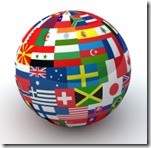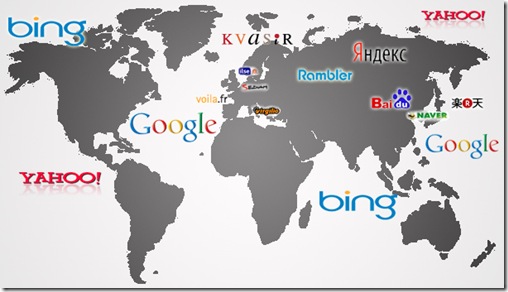So your attempt to market your goods across the globe using search engines that target different countries and a vast array of potential customers doesn’t seem to be yielding much dividends? You’re wondering why you aren’t showing up in Google.de and you’re getting close to tearing your hair in despair? Well, here I will list out some essential tips and guidelines for businesspersons who are reaching out to the world that will help them firmly mark their global business footprint. It is imperative that international brands consider SEO strategies that are tailor-made for them. They may be tricky and complex; they will pose challenges that have to be overcome but if the essentials are kept in mind, the foundation for a profitable campaign will be laid.
Here’s how you go about it. Firstly, conduct market research and then chalk out the strategy that is best for you. It’s not necessary that one strategy will work for one country; in fact, in certain cases, it won’t. For instance, Google may be the dominant search engine, but others have a bigger presence in, for example China and Russia (Baidu and Yandex). All three search engines have their individual algorithms and this will impact your strategy.
Implementation and optimization done without good planning or research are two problems that multinational websites face. The content and structure of the website is extrapolated without considering the fact that different countries/languages have different audiences. Also, the market competition and behavior of the industry may differ.
Let’s take a look at these factors:
- Services and products may be represented differently in countries/languages other than those of your key country/ language.
- Potential customers in different countries/languages won’t necessarily search for service or products with the exact term/phrase that has been translated.
- There may be seasonal, geographical or cultural influences in different countries or languages, especially with regard to festivities.
- Competition in various countries/languages may not be the same; their selling style or their offerings may also differ.
- Local search engines may be more essential than Google so you will have to optimize and rank with regard to them; e.g., in Russia it is Yandex and in China it is Baidu.
International SEO – The Beginning
Let’s look at some of the technicalities and examine, firstly, your site’s domain name for your international SEO. There are two kinds — country-specific and generic top level domain names (TLDN). The former might be abc.fr (France) while a generic name could be abc.org or .biz. or .com etc. In most multinational sites the preferred domain will be generic, while in a few cases a country-specific one would be better.
Structure
When I say ‘structure’ I mean the strategy adopted for your URLs. It’s a vital aspect of moving forward for it can be terribly painful to effect changes in the future. Here are some options:
Domain Directories
Here all languages will be placed in a single generic domain. Each language will be branched out into its respective file; e.g. If we take myexample.com then
myexample.com/en/
myexample.com/de/
myexample.com/fr/
You can also split languages into country codes:
myexample.com/en-us/
myexample.com/en-gb/
A single domain = one SEO operation; handing power to /en/ directory results in a positive, implied effect on /fr/ and /de/.
But single domain too implies one server site; in this case you will be unable to host the /de/ file in Germany or the /fr/ file in France. This could have an effect on load speeds.
Another normal way to target several languages is to move through completely different domain names like:
abc.co.uk
abc.fr
abc.de
For the USA, an.us name may be used, but these kinds of domains are reserved for American citizens and thus are not always suitable. It’s better to register a .com and then make use of Webmaster Tools to get to US users.
Separate ccTLDN have their advantages:
1) There is a sharp difference in locations and so the search engine will not get puzzled about the site to rank.
2) They are able to find servers in local regions which mean quicker load speeds.
3) They are identifiable in SERPs and relied upon by local searchers.
The disadvantages are that the authorization needs links to pass between domains and SEO efforts greatly rise for each new ccTLD used. This approach may be appropriate only for MNCs with huge SEO budgets.
Separate Subdomains
International websites have one final option — multiple-subdomains to target varied users. These are: en.myexample.com; fr.myexample.com; de.myexample.com
Language
 Different languages should not overlap. If a user arrives on .com/de/ then make sure that all routing links direct to other pages in the corresponding directory. Your user will then not risk confusion (Google is watching!) and you strengthen your concentration on that language. You are clearly informing Google that the page is in German — so give me a rank in your .de engine. To give the user the chance to change between languages only a simple top link will suffice.
Different languages should not overlap. If a user arrives on .com/de/ then make sure that all routing links direct to other pages in the corresponding directory. Your user will then not risk confusion (Google is watching!) and you strengthen your concentration on that language. You are clearly informing Google that the page is in German — so give me a rank in your .de engine. To give the user the chance to change between languages only a simple top link will suffice.
Translation
The need to have multi-language content is obvious. Some sites could have English in all their geographical domains and pages but translating the content into the local lingo is the key to getting ranked. However, translation is the real problem! In a best-case situation you may have some in-house linguists who could go through all the pages and turn out great translations. But the reality is quite different; outsourcing content for translation is generally needed. You can go to Elance.com for freelancer translators; there are various forums too where you find freelancers to translate. Pro translation jobs may cost a bit but generally these are better and are often done by native speakers.
Google translate allows you to change content with a choice of a whopping 65 different languages! It’s incredible, free and easy to use! But there’s a catch: syntax and spelling are some of the mistakes that pop up in the Google algorithm. Badly written content limits its capability to rank. Bottom line: you cannot trust automated translation; you might end up getting garbage – without a translator to check! So, depending on the budget, do some professional translation on the most essential landing pages. If you can pay for full professional translation, there’s nothing like it.
Markup
Though a part of all technical SEOs, language markup is not much used and many webmasters are not even aware about it. It is in HTML; it informs Google, besides various search engines, about the language used on a page and where the different languages on the page lie. Google can interpret multi-language content correctly. But it’s good to spell out everything to Google and show them the precise URLs of the variations of the languages used.
Keywords Research
Keywords are the basis of SEO. Without a strong list of them you will be like a blind man shooting at the range. An online business has to define its keywords in order to create its content strategy and marketing endeavor around those terms. To develop an efficient list of keywords you must take this into consideration:
1. Become a ‘customer’ and choose the top likely search terms.
2. Incorporate the most essential keywords into your business strategy.
3. Put your brand names in the list.
4. Key terms that explain your services/products must be listed.
5. State the keywords that best represent your offering/promos.
6. Include your geo-locations like country, region, city, and state, street and so on.
7. Use Google keyword tool or other tools to check out the keywords’ popularity and to get keyword ideas.
Multilingual Keywords
To get best results seek a localization partner and a team of professionals who not only understand the cultural habits of your target language, but who are also specialists in international SEO and SEM best practices with regard to target countries/languages.
Localizing keywords includes these steps:
- Professionally translate keyword list into target languages.
- Adapt keyword list to local languages, geography and culture.
- Research localized keyword phrases in native search engines so as to find out their accuracy.
- Generate expanded list of novel keyword ideas with use of keyword tools.
- Finalize localized list of keywords with most appropriate keywords for localized version of your website.
On-Page SEO
While I suggest that the content that’s translated has much the same meaning as the original, certain elements on-page will have to be changed to match your fresh keyword research. The same on-page SEO standard must be applied in all the languages – canonicalization, content, headers and all that you are used to still have to be considered, in addition to the users intent considerations. But there are some things which you may not have given a thought to, like alt attributes and imagery. If you want to have your pages translated in the best possible way, then don’t forget your Alt attributes. Translation of alt attributes is a minor detail, but it still adds to the SEO benefit on the whole, especially in ranking across nations. I would say that you re-upload all imagery along with their changed file names to go with the particular language. It’s these details that will give you the edge over the competition.
URLs
URLs are simply one more on-page factor, right? Wrong! In international rankings, the translated URLs often are overlooked. So make sure that the URLs have the “lingua franca” of that section and optimize in an appropriate manner. Here is the example of country specific URLs i.e. www.myexample.com/en, www.myexample.com/fr
Address Details
If you operate at a physical location in a country you are targeting be sure to include details of your office on the landing or contact pages. Don’t forget the microdata (www.schema.org/place) and have a Google+ Local account for the same address. You should consider a German Facebook page or/and a Twitter account with German information on LinkedIn. You can have your HQ listed on German directories and then link all these fresh German profiles from your German URLs!
Link Building
Link building needs precisely the same exercise you are used to. A little change in focus is required for ranking for another geographical region. If you’re attempting to rank a French page on your website, try to get .fr links. But don’t think about declining links from different ccTLDs/gTLDs in full favor of a completely significant extension. Where it can be done, seek .com’s and .net’s and so on that are written in the suitable language. These sites may be defined by the search engine as French/German. This will raise the off-page significance of your site in respect to any country. But don’t make this the norm for all.
International SEO: Frequent Errors
Many webmasters take the JavaScript route only because it’s simple but this kind of translation has very little positive effect on your SEO endeavor. So keep international content on different URLs and their translation as HTML text.
The thumb rule is to avoid splash pages (frequently the homepage) that give many options – here languages — for users to click. They only generate a needless step for users and weaken your ranking ability.
Your server will not know best all the time. A user may land from a German I.P on your page, but is seeking English content. This forces him/her to move to that language segment and he/she will quit your engagement. An unobtrusive way – a banner to advocate that they may like to see the German content — is a much better option.
In Conclusion
International SEO is not restricted to multi-nationals that have their presence all over the world, with employees and offices spreading their tentacles across the globe. Though expensive, I feel international SEO can also be important to medium and small businesses that sell all over the world from one location. I hope this article will help you in your international SEO practice. I will appreciate it if you send me your comments.
image credit: smartinsights.com










Barb
Wow. These ideas are mostly way beyond my paygrade, but look really brilliant. I think I’ll start slow and keep coming back to this post as a reference, so thank you.
Also, I was wondering if you don’t mind sharing, how do you do your social networking buttons as you do, the cute circles on the top lefthand side?
Thanks for your help here!
~Barb
I am using the plugin form “Flare”. Just go to WordPress dot org and search for Flare.. You should be able to find it without problems and it is easy to install 🙂
Barb
DiTesco,
Thanks so much for your reply, and quickly! Love your site, thanks!! :))
~Barb
Evan
Local and general SEO are both marketing strategies increasing the rate of traffic. Everywhere and Always. Just have one question – how can localize SEO be utilized for an online company with clients in cities all over the United States, Canada and Mexico?
Alan Smith
The same question entered my mind and I did some research on it. The outcome of the research is here as a post. If you think that I have stilll forgotten some things, kindly mention them to me.
In my opinion, multiple keywords can cause problems in SEO. As you start SEO, first should focus on some keywords then after when they get ranking, other keywords should be focused.
Alan Smith
Yes, you are right. We should go for long tail keyword first.
Study Medicine Abroad
I was questioning if you don’t mind sharing, however does one do your social networking buttons as you are doing, the lovable circles on the highest lefthand aspect
Off topic but I am using the plugin Flare :). You can find it on wordpress.org..
Osho Garg
SEO is certainly very important to get good rank in Search result. You added some good points to improve SEO. But I think the most important thing to write unique & useful content.
Alan Smith
By providing unique and vital content you can target your customers and increase your popularity. Unique and attractive content helps you to generate trust among readers and they engage in it and in future they will come back to your website.
Essay writing Help
Optimizing for international markets is not simple because at times you do not know the culture and consumption trends of your targeted market. For this reason to succeed in this you should make a research on the consumer trends of your targeted market and see what is the best approach to use. For example if you sell clothes try to know what class of consumers or age group where what type of clothes. Equally if you offer services you should know what class or which individuals go for particular services.
It’s important even before you start focusing on international optimization to follow the basic rule of thumb and establish whether what you sell has or can have a market at you targeted region. There are some countries where culture and taboos does not allow certain things meaning targeting those ones it will be just like tossing money down the drain.
Alan Smith
Yes, when you are targeting international SEO you need to go deep into international market research. You need to do research such as popular keywords for specific regions and much more. When you do it properly you can target your aim.
James
Hi Alan, this post cleared some of my oldest doubts about international seo. I must say that you explained everything in such a simple and easy way, I felt as if I knew it all through. Thanks a lot for sharing.
Alan Smith
Thanks James for your feedback. I am very grateful that it cleared all your doubts.
“I personally prefer to use minimum number of plugins and use Thesis theme for most of my websites which gives me much finer control on each post and page level. In case I have to use a plugin, I will go with Yoast SEO or All in One SEO
“
Kamrun
Some really nice points, out of box. All the while I was reading those common tips about SEO. I will start and will refer to your blog consistantly. Thanks a ton for sharing.
Andru
People not showing up or high bounce rate is very annoying. I think Being socially active is one key ingredients to having more readers. Some great tips, I will surely follow them to increase visitors to my site.